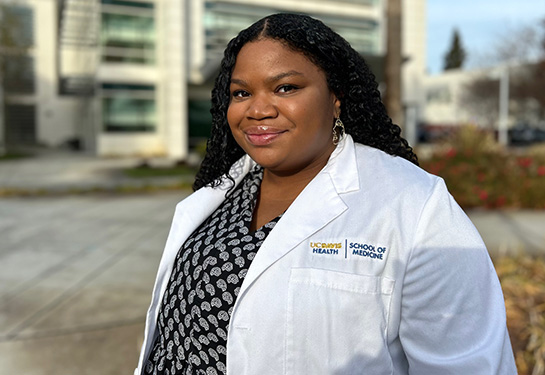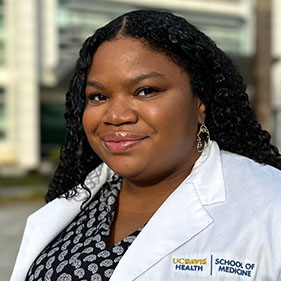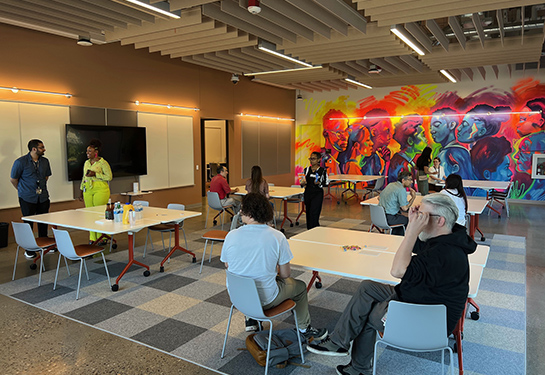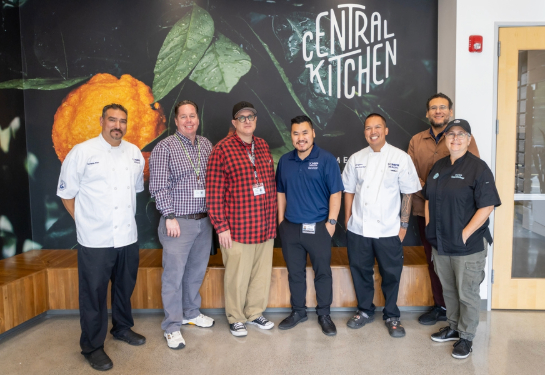Medical student is on a mission to bring healing to marginalized populations
Chelsea Nash once thought Black people couldn’t be doctors — now she’s set on becoming one
Chelsea Renee Geraldine Nash watched helplessly as her mom agonized in an East Bay emergency room.
“I’m in so much pain!” her mom cried out to the medical personnel wearing scrubs and lab coats, “Please help me!”
Nash, about 9 years old, was well aware of her mom’s painful, lingering health conditions and disliked how doctors were reacting. “One physician after another came in and they were basically saying, ‘there’s nothing wrong with you,’” Nash recalled. “Then they said to my mother, ‘if you don’t leave, we’ll have you escorted out.’”
Nash, the grandchild of 1960s Black Panther activists, suspects the mistreatment could have been race related. She and her mom are Black, and they never saw doctors who looked like them.
But the experience was so impactful that it became a catalyst for Nash’s career choice: She is now a second-year student at the UC Davis School of Medicine.
“I would love to be able to help people like my mother who was hurt and who has pain that often goes unnoticed or dismissed,” Nash said. “I want to be the kind of doctor who will say, ‘hey, I know your pain is valid and I’m going to give you the best care possible, even if your condition isn’t detected in the lab results.’”
I would love to be able to help people like my mother who was hurt and who has pain that often goes unnoticed or dismissed. I want to be the kind of doctor who will say, ‘hey, I know your pain is valid and I’m going to give you the best care possible, even if your condition isn’t detected in the lab results.’”—Chelsea Nash
“I didn’t think Black people could be doctors”
Nash was born in Berkeley and attended public schools in Oakland until her mother, a social worker, applied for an interdistrict transfer, hoping for a better education for her daughter. So, after eighth grade graduation, Nash took buses and BART to Castro Valley High School.
She excelled there and began to contemplate nursing — her grandmother was a licensed vocational nurse — but a friend talked her out of it. Medicine, the friend said, was more aligned with Nash’s love for research and her desire to advocate for patients who are marginalized in health care settings.
But Nash had a hard time picturing herself as a physician.
“I never saw a Black doctor, to be honest,” she said. “I know it sounds foolish, but I didn’t think Black people could be doctors.” Her reasoning? “You can’t be what you don’t see.”
During her senior year, Nash began to explore colleges in the South and on the East Coast, hoping to surround herself with a network of African American students.
She chose Virginia State University, a small and historically Black college. She also was awarded the school’s Presidential STEM scholarship, which covered four years of tuition, room and board.
Nash helps organize a support system for future medical students
Nash fell in love with Virginia State but quickly noticed a glaring omission: A support system for students who dreamed of becoming doctors. She was, after all, recruited to study for a career rooted in science. But the school lacked a pre-medicine track in its curriculum or a pre-medical student-run organization.
Nash and her friends vowed to fix that.
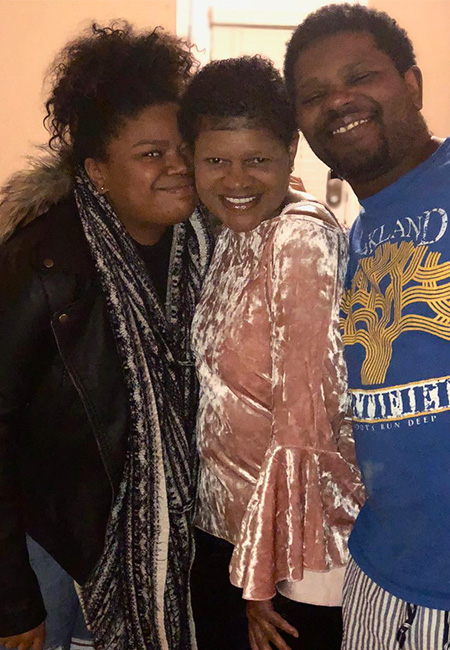
They founded the school’s chapter of the Minority Association of Pre-Medical Students, or MAPS, which is the undergraduate arm of the well-known Student National Medical Association, or SNMA.
Next, the budding leaders worked with professors to establish a much-needed academic track for pre-medical, pre-dental and pre-physician assistant students.
“It felt so amazing,” Nash said, “we were finally making some changes and we were finally getting the same value of education as our counterparts in other schools, which we deserved.”
Building the MAPS chapter from scratch was hard work, but it quickly paid off.
It wasn’t long before students connected with mentors, invited physicians to speak at their gatherings, raised funds to attend medical conferences across the country and landed summer internships. The organization also gave them access to tour medical schools including Howard University, Duke University and Eastern Virginia Medical School.
“What really moved me,” Nash said, “is that this was the first time that a lot of students, myself included, had ever been to a medical school campus.”
The pre-med students formed a tight bond over their endeavors. “There was so much camaraderie,” Nash said. “Our catch phrase was, if I pass, you pass, we pass and no one gets left behind.”
The brand-new MAPS team was so successful and inspirational, it was nominated for chapter of the year at the annual SNMA conference.
A family tragedy sends Nash packing to the Midwest
The summer between her junior and senior years, Nash enrolled in a competitive, 8-week global health internship through the University of Virginia in Charlottsville. She was tasked with researching public health in the Caribbean country of Saint Kitts and Nevis.
That experience propelled her to seek a master’s degree in global health.
After graduating from Virginia State magna cum laude in 2019 she enrolled at UCSF. Then her life took a couple of unexpected turns – the coronavirus pandemic disrupted the world, and Nash’s mother, who was now in Indiana, was diagnosed with Stage 3 laryngeal cancer.
Nash quickly moved to Indiana and became an expert multitasker. She chauffeured her mom to radiation and chemotherapy appointments, worked on the master’s projects, cooked for her mom, studied for the Medical College Admission Test (MCAT), dispensed medicine and changed bandages for her mom, then studied some more.
She succeeded in finishing the degree, and doctors later declared Nash’s mother to be cancer free.
Choosing which medical school to attend
Nash moved back to California where two medical schools extended offers: UCSF and UC Davis. Nash was unsure which to choose.
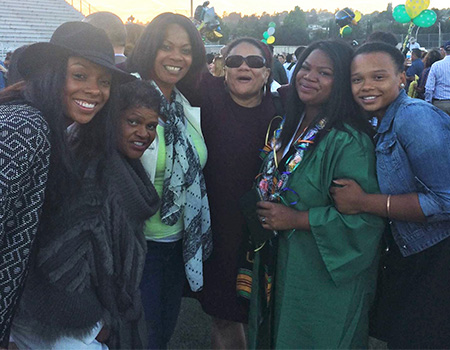
“UCSF had my heart, you know, because I went there for my master’s and it’s one of the top medical schools in the country," Nash said. But there was something drawing her to UC Davis, too – the sense of a tight-knit, supportive community.
Visiting the campuses was impossible during the pandemic, so she attended Zoom conferences hosted by both schools where students and faculty boasted about their programs.
UC Davis, Nash recalled, gave her the vibe that students felt their colleagues and professors cared for them. Of note, she remembers UC Davis internal medicine Professor Jorge García open up about his rocky journey through medical school, and how he is now in a position to encourage students who get discouraged.
Beyond the Zoom sessions, Nash did her own research. She chased down random UC Davis and UCSF students on Twitter and direct messaged them to get their off-scripted scoop on their schools.
“UC Davis and UCSF are pretty comparable in terms of academics, but I wanted to go somewhere where I felt like I could call someone if I needed help or could be friends with my professors and have a really solid support system,” Nash said.
Nash was convinced she needed to be at UC Davis.
Life at the UC Davis School of Medicine
Ever since coming to the Sacramento campus, Nash, who describes herself as “really extroverted,” has been fully involved in activities and academics.
She taught in the Health Equity Academy, the UC Davis School of Medicine program that introduces schoolchildren to careers in medicine. She mentored high school students. She became the mental health clinic coordinator at Imani, the student-run clinic. She joined the pediatric student-run interest group. And she was elected as the social chair of SNMA.
She’s known on campus for being a genuinely helpful person. She’s also a trusted advocate for students when they need someone to express concerns to faculty on their behalf.
“In clinical skills class, Chelsea is often the first person to speak about what the other students in the class have done correctly in a simulated patient encounter,” said her academic coach, Erik Fernandez y Garcia, an associate professor of pediatrics. “She is extremely attuned to providing positive reinforcement. At the same time, her constructive feedback is generally spot-on and important,” he said.
Nash belongs to the TEACH-MS pathway, an acronym for Transforming Education and Community Health for Medical Students. It’s a program that prepares a select group of students to fill the shortage of doctors in urban, underserved settings.
Just like the Oakland neighborhood she grew up in.
“I want to work with historically marginalized populations, that's just my jam,” Nash said. “I just I want to help people. I want to be like the people who once served me when I received care from Federally Qualified Health Centers. I think that’s my dream life.”

